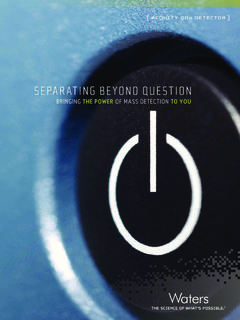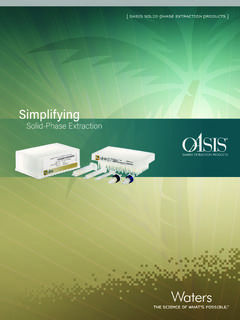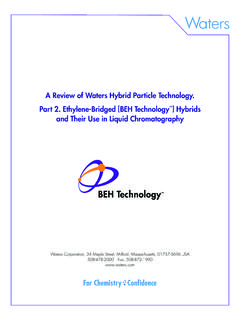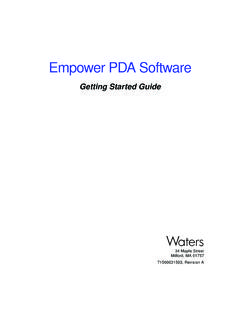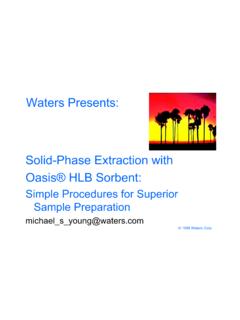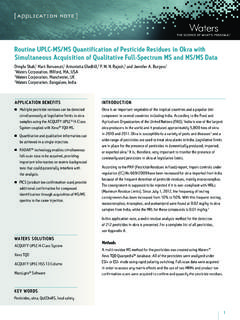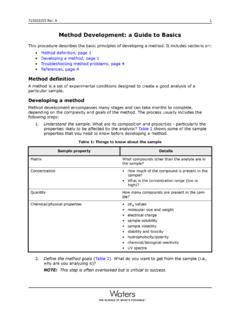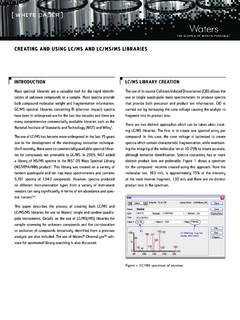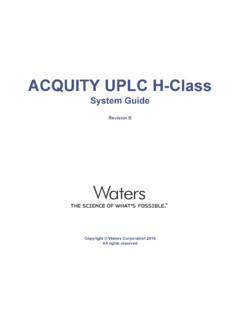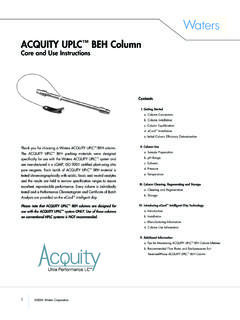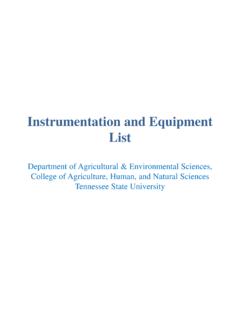Transcription of 2424 Evaporative Light Scattering Detector Operator’s Guide
1 2424 Evaporative Light Scattering DetectorOperator s Guide71500121802/Revision BCopyright Waters Corporation 2006 2009 All rights reservediiCopyright notice 2006 2009 WATERS CORPORATION. PRINTED IN THE UNITED STATES OF AMERICA AND IN IRELAND. ALL RIGHTS RESERVED. THIS DOCUMENT OR PARTS THEREOF MAY NOT BE REPRODUCED IN ANY FORM WITHOUT THE WRITTEN PERMISSION OF THE information in this document is subject to change without notice and should not be construed as a commitment by Waters Corporation. Waters Corporation assumes no responsibility for any errors that may appear in this document. This document is believed to be complete and accurate at the time of publication. In no event shall Waters Corporation be liable for incidental or consequential damages in connection with, or arising from, its , PIC, and Waters are registered trademarks, and busLAC/E, PowerStation, and THE SCIENCE OF WHAT S POSSIBLE.
2 Are trademarks of Waters is a registered trademark, and MassLynx is a trademark of Micromass is a registered trademark of Phillips Screw registered trademarks or trademarks are the sole property of their commentsWaters Technical Communications department invites you to tell us of any errors you encounter in this document or to suggest ideas for otherwise improving it. Please help us better understand what you expect from our documentation so that we can continuously improve its accuracy and seriously consider every customer comment we receive. You can reach us at WatersContact Waters with enhancement requests or technical questions regarding the use, transportation, removal, or disposal of any Waters product. You can reach us via the Internet, telephone, or conventional considerationsSome reagents and samples used with Waters instruments and devices can pose chemical, biological, and radiological hazards.
3 You must know the potentially hazardous effects of all substances you work with. Always follow Good Laboratory Practice, and consult your organization s safety representative for you develop methods, follow the Protocol for the Adoption of Analytical Methods in the Clinical Chemistry Laboratory, American Journal of Medical Technology, 44, 1, pages 30 37 (1978). This protocol addresses good operating procedures and the techniques necessary to validate system and method contact informationContacting mediumInformationInternetThe Waters Web site includes contact information for Waters locations worldwide. Visit and faxFrom the USA or Canada, phone 800 252-HPLC, or fax 508 872 other locations worldwide, phone and fax numbers appear in the Waters Web mailWaters Corporation34 Maple StreetMilford, MA 01757 USAvSafety advisoriesConsult Appendix A for a comprehensive list of warning and caution this instrumentWhen operating this instrument, follow standard quality-control (QC) procedures and the guidelines presented in this symbolsAudience and purposeThis Guide is intended for personnel who install, operate, and maintain 2424 Evaporative Light Scattering (ELS)
4 Use of the 2424 ELS detectorWaters designed the 2424 ELS Detector to analyze and monitor many that a manufactured product complies with all applicable European Community directivesAustralia C-Tick EMC CompliantConfirms that a manufactured product complies with all applicable United States and Canadian safety requirementsThis product has been tested to the requirements of No. 61010-1, second edition, including Amendment 1, or a later version of the same standard incorporating the same level of testing requirementsABN 49 065 444 751viCalibratingTo calibrate LC systems, follow acceptable calibration methods using at least five standards to generate a standard curve. The concentration range for standards should include the entire range of QC samples, typical specimens, and atypical calibrating mass spectrometers, consult the calibration section of the operator s Guide for the instrument you are calibrating.
5 In cases where an overview and maintenance Guide , not operator s Guide , accompanies the instrument, consult the instrument s online Help system for calibration run three QC samples that represent subnormal, normal, and above-normal levels of a compound. Ensure that QC sample results fall within an acceptable range, and evaluate precision from day to day and run to run. Data collected when QC samples are out of range might not be valid. Do not report these data until you are certain that the instrument performs classificationISM Classification: ISM Group 1 Class BThis classification has been assigned in accordance with CISPR 11 Industrial Scientific and Medical (ISM) instruments requirements. Group 1 products apply to intentionally generated and/or used conductively coupled radio-frequency energy that is necessary for the internal functioning of the equipment.
6 Class B products are suitable for use in both commercial and residential locations and can be directly connected to a low voltage, power-supply Authorized RepresentativeWaters Corporation (Micromass UK Ltd.)Floats RoadWythenshaweManchester M23 9 LZUnited KingdomTelephone:+44-161-946-2400 Fax:+44-161-946-2480 Contact:Quality managerviiiTable of ContentsixCopyright notice .. iiTrademarks .. iiCustomer comments .. iiiContacting Waters .. ivSafety considerations .. iv Safety advisories .. vOperating this instrument .. v Applicable symbols .. v Audience and v Intended use of the 2424 ELS v Calibrating .. vi Quality-control .. viISM classification .. vi ISM Classification: ISM Group 1 Class B .. viEC Authorized Representative .. vii1 2424 ELS Detector Optics Principles.
7 1-1 Principles of Evaporative Light Scattering detection .. 1-2 1-2 Capabilities .. 1-2 ELS detection 1-2 detection .. 1-4 ELS detection 1-6 Detector description .. 1-7 Signal processing and noise 1-8 Calibrating the photomultiplier tube (PMT) .. 1-8 Filtering noise .. 1-8 Electronics and data acquisition .. 1-9 Table of ContentsxTable of Contents Nebulizer .. 1-9 Optics bench .. 1-9 Temperature control .. 1-10 Startup diagnostics .. 1-11 Lamp energy and performance .. 1-12 Rear panel .. 1-13 References .. 1-132 Setting up the Detector .. 2-1 Introduction .. 2-2 Before you begin .. 2-2 Unpacking and inspecting .. 2-3 Selecting a site within a laboratory .. 2-3 Site selection requirements.
8 2-4 Detector dimensions .. 2-5 Power 2-6 Gas 2-7 Making the gas supply connection .. 2-7 Venting the exhaust hose .. 2-8 Connecting to the electricity source .. 2-11 Installing the nebulizer assembly .. 2-12 Connecting the siphon drain tubing .. 2-14 Routing the siphon drain tubing down the front of the 2-14 Routing the siphon drain tubing to the rear of the Detector .. 2-15 Connecting the drip tray .. 2-18 Required materials .. 2-18 Connecting the nebulization gas to the nebulizer .. 2-19 Connecting a column or second Detector .. 2-19 Required materials .. 2-19 Table of ContentsxiMaking signal connections .. 2-20 Connecting the Ethernet 2-22 Network installation 2-23 Connecting to other instruments.
9 2-25 Connecting the Waters column heater module .. 2-333 Operating the Detector .. 3-1 Starting up the Detector .. 3-2 Initializing the Detector .. 3-2 Using the display .. 3-4 Detector Home and Message screen icons .. 3-5 Using the keypad .. 3-7 Navigating the user interface .. 3-13 Navigating to and from the Home 3-13 Preparing to start a run .. 3-15 Primary and secondary functions .. 3-15 Setting up a run .. 3-17 Setting the nebulizer and drift tube temperature .. 3-18 Setting the gain and gas pressure .. 3-19 Setting the column heater module temperature .. 3-21 Resetting the stop flow output switch .. 3-21 Operating the trace and scale functions .. 3-22 Setting the data 3-24 Setting the filter time constant.
10 3-24 Setting the switch output .. 3-25 Setting the analog signal 3-25 Setting auto zero options .. 3-25 Configuring the Detector .. 3-26 Configuring event 3-27 Configuring stop flow 3-28 Setting pulse periods .. 3-28 Selecting the type of nebulizer .. 3-29 Setting the display contrast .. 3-29xiiTable of Contents Displaying system information .. 3-30 Using help .. 3-30 Operating the Detector .. 3-30 Standalone 3-31 Auto-optimizing gain and LSU-FS .. 3-31 Programming methods and events .. 3-34 Overview of methods .. 3-34 Programming timed events .. 3-35 Programming threshold 3-37 Storing a 3-38 Retrieving a method .. 3-39 Viewing events within a 3-39 Resetting a method .. 3-39 Clearing events .. 3-40 Conserving lamp life.
